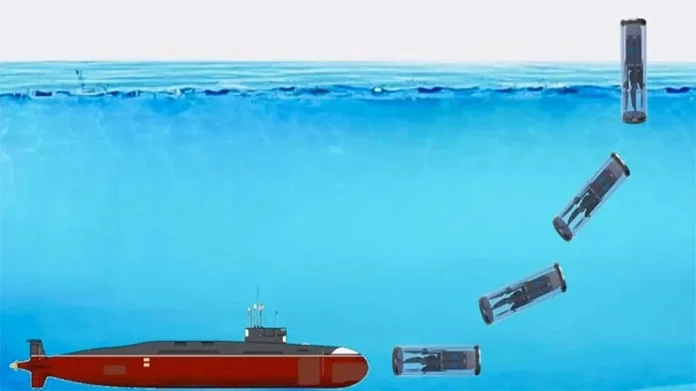New Delhi: Pune based Sagar Defence Engineering has secured a contract from the Defence Research and Development Organisation’s (DRDO) Technology Development Fund (TDF) to develop underwater launched unmanned aerial vehicles (ULUAVs).
Aiming to enhance the strategic prowess of Indian defence forces and boost the nation’s underwater capabilities, this ground-breaking project showcases a major leap in India’s defence technology. The agreement pertains to developing a ULUAV that will launch from a submarine and operate autonomously, with the ability to land on another moving vessel. It will also come equipped with technologies such as cameras, sonar, and other sensors to collect data.
Sagar Defence Engineering emerged victorious in a competitive bidding process that saw participation from 17 firms. The development of an underwater launched unmanned aerial vehicle (ULUAV) by Sagar Defence Engineering Pvt. Ltd. is designed to launch autonomously from a moving submarine, featuring high endurance and long range to provide a significant element of surprise.
Highlighting the collaborative effort to propel India’s defence technology to new heights, the contract was officially signed between Dr Nidhi Bansal, Director of TDF, and Sagar Defence Engineering Pvt. Ltd. in the presence of Dr GA Srinivasa Murthy, Director of the Defence Research & Development Laboratory (DRDL) in Hyderabad and the Indian Navy along with TDF officials.
With its rapid, safe, and autonomous deployment capabilities, the system will be capable to conduct discreet surveillance missions, enabling submarines to monitor threats without detection. Designed to move seamlessly from underwater to the surface and into the air, maintaining continuous communication, this compact unmanned system provides submarines with real-time surveillance for effective target identification. This innovation significantly enhances the ability of submarines to remain discreet while staying informed and connected, transforming the dynamics of underwater and aerial military operations.
Sagar Defence Engineering in a press statement said that the ULUAV will have high endurance and long range, and hence, it will have a huge surprise element advantage. It will be capable of being deployed quickly, safely, and autonomously from a moving submarine.
In this project, the Indian Navy will be collaborating extensively with industry partners to explore the potential of ULUAVs and develop new strategies. As this technology allows submarines to expand their command and control capabilities, the ULUAV provides high tactical advantage, achieved through RF data-link transmissions that can reach the submarine positioned under the ocean’s surface. Significantly enhancing the submarine’s sensor range and operational capabilities, the ULUAV will be utilised for conducting intelligence, surveillance, and reconnaissance (ISR) missions, providing radio relay by seamlessly integrating into the existing fleet for mid-term operational advantages. As submarines cannot observe beyond the horizon visible through their periscope, deploying the ULUAV while submerged will greatly enhance the submarine’s situational awareness and deceptive capabilities, gaining significant strategic and tactical advantage to engage with multiple targets simultaneously.
“Operating in tandem with the ULUAV enables discreet surveillance missions, allowing submarines to monitor potential threats without revealing their presence. This innovation represents a paradigm shift in naval defence technology, offering unparalleled flexibility and precision in underwater engagements (sic),” the press statement from Sagar Defence Engineering further said.
The ability to deploy autonomous aerial vehicles from underwater platforms will be a critical factor in maintaining maritime security. The introduction of the ULUAV into the Indian Navy’s fleet will not only enhance current operational capabilities but also pave the way for future advancements for such type of autonomous and unmanned maritime systems.
According to Sagar Defence Engineering Chief Executive Officer Captain Nikunj Parashar, the involvement of TDF and DRDL will create a bridge among the armed forces, SDEPL (Sagar Defence Engineering Private Limited), and certifying agencies. The TDF will also assist Sagar Defence Engineering with the development of the ULUAV. They will also provide the grant in aid for the project and also provide technical assistance and mentorship while the project progresses, along with technology development vetting.
To its credit, Sagar Defence Engineering earlier developed the maritime spotter drone for the Indian Navy, with the capability to take off and launch from a moving platform.
“The ULUAV provides a high tactical advantage, achieved through RF (radio frequency) data-link transmissions that can reach the submarine positioned under the ocean’s surface,” said Nikunj Parashar. Adding, “ The ULUAV, which will significantly enhance submarine sensor range and operational capabilities, will be used for conducting intelligence, surveillance, and reconnaissance (ISR) missions, providing radio relays by seamlessly integrating into the existing fleet for mid-term operational advantages.”
“As submarines cannot observe beyond the horizon visible through their periscope, deploying the ULUAV while submerged will greatly enhance the submarine’s situational awareness and deceptive capabilities, gaining significant strategic and tactical advantage to engage with multiple targets simultaneously,” he said and added that the ability to deploy autonomous aerial vehicles from underwater platforms will be a critical factor in maintaining maritime security.
The agreement between TDF DRDO and Sagar Defence Engineering Pvt. Ltd. will lead to a new dimension in naval warfare for revolutionising intelligence gathering, surveillance, and reconnaissance, amplifying maritime operational efficacy by the use of ULUAVs. It also marks a significant stride in the government’s commitment to bolstering the roadmap towards an indigenous defence industry and the nation’s technological progress.





